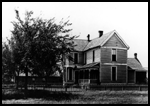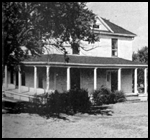|
Lost
Buildings |
|
In the nineteenth century, only a few buildings were
located on the south side of the campus along E. College Street. |
|
 In 1903, Captain J. M. Thompson
leased to and later gave to the college a large house on the south side of the campus
that, after the Russo-Japanese war in 1905, came to be known as Togo House. The Thompson
family had lived in it during the 1890s while their permanent residence, now known as
Thompson House, was being constructed. Togo House provided accommodations for a relatively
short time as it burned to the ground on April 27, 1910. In 1903, Captain J. M. Thompson
leased to and later gave to the college a large house on the south side of the campus
that, after the Russo-Japanese war in 1905, came to be known as Togo House. The Thompson
family had lived in it during the 1890s while their permanent residence, now known as
Thompson House, was being constructed. Togo House provided accommodations for a relatively
short time as it burned to the ground on April 27, 1910. |
|
|
|
 In 1922, members of the Alumni Association
purchased a twenty-acre tract adjoining the campus and gave it to the college for the
athletic program. Luckett Field was abandoned in favor of the new area named Cashion Field
in honor of Mason Cashion, long-time secretary of the campus Y.M.C.A. who had also served
for a time as athletic director. Cashion Field was located on the southeast corner of E.
College and Bledsoe. In 1922, members of the Alumni Association
purchased a twenty-acre tract adjoining the campus and gave it to the college for the
athletic program. Luckett Field was abandoned in favor of the new area named Cashion Field
in honor of Mason Cashion, long-time secretary of the campus Y.M.C.A. who had also served
for a time as athletic director. Cashion Field was located on the southeast corner of E.
College and Bledsoe. |
|
|
|
|
|
A large gymnasium was built on the Cashion Field
property in 1927 and named for Pete Cawthon, the coach who had inspired its construction
by having his athletes build it. Located on E. College where
it intersected N. Hurt, the gym provided the men with a full-sized basketball court for
the first time, while the women continued to use the small gym in the Y building. |
|
|
|
|
|
Just east of Cawthon Gym was a white frame building
that housed the Music department until Craig Hall was built in 1962. |
|
|
|

A block east of these buildings stood the first
dormitory for women, Coffin Hall, erected in 1949 for the college’s centennial
celebration. To make way for the centerpiece of the sesquicentennial, the new Student
Center, Coffin Hall was demolished in 1998. |
|
|
|
 Two blocks south of the campus at the
northwest corner of Lee Street and E. Brockett stood Lee House, a boarding house that was
eventually acquired by the college and served students into the late 1970s. |
| |
|
|
 Also in the extreme southwest sector
of the campus during the 1940s stood a complex known as Vet Village.
A flood of
returning World War II veterans engulfed the AC campus in the spring of 1946. To provide
housing for these students, the college negotiated a contract with the federal government
to build a total of fifty housing units for veterans on the south and west sides of
Cashion Field on the north side of E. Brockett between Porter and Bledsoe.
|
|
|
| |
 In 1955, Vet Village underwent a
facelift. Three two story units were sided with the wonderful new fire-proof material,
asbestos, and moved to the south side of Brockett Street to form a quadrangle with two
smaller units attached to the east and west wings. In 1955, Vet Village underwent a
facelift. Three two story units were sided with the wonderful new fire-proof material,
asbestos, and moved to the south side of Brockett Street to form a quadrangle with two
smaller units attached to the east and west wings.
Completely refurbished inside, the larger units had four apartments and the
smaller units, two. The quadrangle area was landscaped and furnished with
yard equipment. There were sixteen apartments that commanded a waiting list
from the married students attending Austin College. South of these units on
Pacific Street were smaller units, some duplexes, some single apartments |
| |
|
|
Over the years the campus vista has changed
dramatically from Davis Foute Eagleton’s dreary first impression of a dark gothic
hulk in the middle of a weed field. As the College Park suburb grew up around the small
campus, the campus gradually expanded into its suburban surroundings. These buildings and
many others, such as the John Vinson house on the south side of the campus in the 1880s;
the Tucker Inn, home of President E. B. Tucker during the 1930s and ‘40s, and the
College Day Care Center in the1980s, both on Grand Avenue, played important roles in the
life of Austin College and witnessed much of its untold history. With only one or two
exceptions, they are all gone now, but if those walls could talk, what stories might they
tell? |
|
|
|
 |
 main
page | map main
page | map |